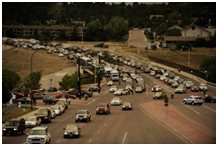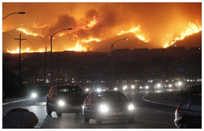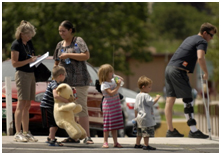
 All emergencies are different, so when it comes to talking about an emergency evacuation, it’s hard to plan for what may happen. For instance, in the event of a hazardous materials spill or wildland fire, you may be required to evacuate with little to no notice. In other situations, such as people living downstream from moving flood waters, you may have a few minutes to several hours to even a few days notice to evacuate.
All emergencies are different, so when it comes to talking about an emergency evacuation, it’s hard to plan for what may happen. For instance, in the event of a hazardous materials spill or wildland fire, you may be required to evacuate with little to no notice. In other situations, such as people living downstream from moving flood waters, you may have a few minutes to several hours to even a few days notice to evacuate.
Evacuation orders can be issued by local governments or first responders. When possible, evacuation details are broadcast to the public via radio, television, NOAA All-Hazard Radios, and Reverse 911 which can be sent via email, voicemail, or text messages. If an evacuation message is issued for your area, be alert for the specific instructions on how, where and when to evacuate.
 In situations where an evacuation is urgent, first responders may actually go door to door for those in the greatest danger. Some disasters unfold so quickly that the need for you to evacuate may arise before you can receive official direction to do so. In this scenario, it is best to go with your gut, and take the necessary actions to protect you and your family. Self-evacuation requires keen senses of observation, situational awareness, knowledge of the area, and common sense to avoid evacuating into a danger zone.
In situations where an evacuation is urgent, first responders may actually go door to door for those in the greatest danger. Some disasters unfold so quickly that the need for you to evacuate may arise before you can receive official direction to do so. In this scenario, it is best to go with your gut, and take the necessary actions to protect you and your family. Self-evacuation requires keen senses of observation, situational awareness, knowledge of the area, and common sense to avoid evacuating into a danger zone.
Some important considerations to account for when determining whether to self-evacuate:
- Have you called 911 for information?
- Do you feel your life may be in danger?
- Have you gotten any notice from Emergency responders or local officials?
- Do you smell a foul odor, hear a disturbing sound, or see a dangerous situation?
- Are you in contact with your family and do they know your intentions?
- Do you know a direct route out of the area?
- Do you have a predestinated evacuation location?
- Do you have all necessary personal items (i.e. cell phone charger, medications, identification, money/ credit cards, and other items) to be away from home for multiple days?
- Are you aware of where your family members are (i.e. children and pets)?
- Are there any neighbors you know of that would need help evacuating?
Before evacuating, remember the following last-minute items when possible:
- Take a battery-powered radio.
- Take your pets with you; do not leave them behind.
- Wear protective clothing and sturdy shoes.
- Take your disaster supply kit.
- Lock your doors as you leave.
- Gather essential paperwork.
- Turn off utilities (water, gas and electricity) if you are instructed to do so.
- Let someone know where you are going.
Evacuations Planning
Evacuations are a stressful and serious event, both for the responders and those citizens impacted. Preplanning with your family and cooperating with the local authorities is crucial to a safe and successful evacuation. When preparing for an evacuation, consider the two most important steps: 1) develop a family evacuation plan, 2) develop a Go-Kit, (smaller version of an emergency kit).
If you don't have a car, plan for alternate transportation, such as riding with a neighbor. If you do have a car, try to always keep the gas tank at least half full.
 When building a family evacuation plan, incorporate three aspects:
When building a family evacuation plan, incorporate three aspects:
- Local maps of the primary and secondary evacuation routes.
- Identify potential meeting places for family members and designate an out-of-town contact.
-
Check list of the necessary items that you will need.
For examples of how to build a Go-Kit / portable emergency kit, visit http://www.redcross.org/prepare/location/home-family/get-kit.





